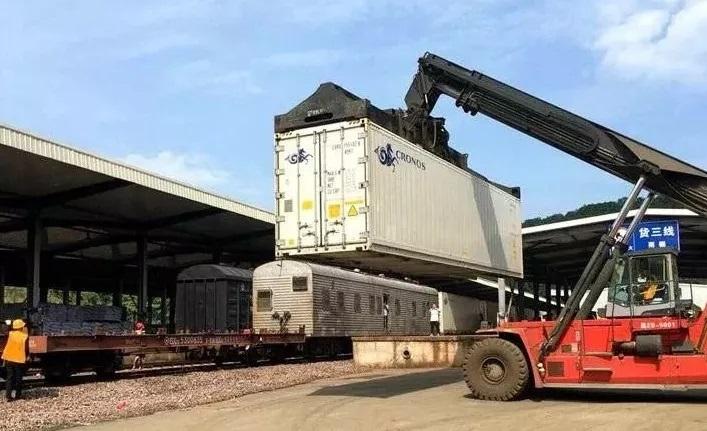Zoals we allemaal weten, railway transportation is suitable for the transportation of long-distance and large quantities of goods, and the refrigerated food production and marketing places are far away, which provides favorable external conditions for the development of cold chain logistics. Echter, van de huidige situatie, China’s railway refrigerated transport volume is relatively small, goed voor minder dan 1% of the total demand of social refrigerated transport, which does not give full play to the advantages of railway in long-distance transport. RFID cold chain management tag in railway is very helpful.

I. belangrijkste problemen in de traditionele modus
1. Het transportproces is ondoorzichtig: in order to reduce the cost, the third-party transportation enterprise may shut down the refrigerator in the transportation process and turn on the refrigerator when it arrives at the destination quickly, die niet de hele koude keten kan bereiken. En wanneer de goederen worden afgeleverd, hoewel het oppervlak goed bevroren is, the quality has actually declined.
2. Het opslagproces is niet transparant: due to cost considerations, the storage enterprise may use the low power period at night to start up, en de apparatuur wordt overdag uitgeschakeld, resulting in the temperature fluctuation of the cold storage exceeding 10 ℃, en de voedselkwaliteit wordt verminderd. The traditional monitoring method is to use a temperature recorder to measure, die netwerk- en menselijke tussenkomst vereist om gegevens te exporteren, and the data is in the hands of the carrier and the storage enterprise. If the owner wants to obtain data, het is moeilijk. Momenteel, some large domestic pharmaceutical companies and food enterprises prefer to invest a lot of money to build their own refrigerators and transport fleets, rather than use the third-party cold chain logistics enterprise services, wat natuurlijk erg duur is.
3. Ongeldige afhandeling: when the transport enterprise picks up the goods, als het ze niet met pallets kan vervoeren, the workers need to transport the products from the pallets to the refrigerated trucks; after the goods arrive at the storage or retail enterprises, the workers need to unload the goods from the refrigerated trucks and put them on the pallets, which is easy to cause packaging damage and affect the quality of the goods.
4. Lage efficiëntie van magazijnbeheer: paper documents shall be provided before entering and leaving the warehouse, and then manually entered into the computer, which is inefficient and has high error rate.
5. Afval van menselijke hulpbronnen: loading and unloading of goods and palletizing need a lot of manpower.
II. Optimalisatiestrategie
1. Build a modern railway cold chain logistics center to provide a full range of services from transportation, opslag, sorteren, distributie, enz.
2. Gebaseerd op de toepassing van RFID-technologie, the pallet is introduced into the field of cold chain logistics (dat is, the electronic label is built on the pallet). It is very important to realize the electronic information of pallet for improving the level of logistics management and reducing the cost of logistics.
3. Introduceer het concept van palletdeling. Provide or lease the pallet embedded with temperature label to the cooperative manufacturer for free, realize the consistent transportation of pallet operation in the railway cold chain logistics center, improve the logistics efficiency and reduce the cost.
III. Geoptimaliseerde logistieke modus van de koelketen
1. Opslag: bij het betreden van het magazijn, the basic information of the pallet goods (inclusief productiedatum, type, gewicht, enz.) wordt geschreven door de handsetterminal te binden.
2. vervoer: the goods are transported together with the pallet. The temperature sensor in the electronic label can collect the temperature information at any time and transmit it to the enterprise in real time through GPRS, so that the enterprise management personnel can grasp the temperature situation in the compartment before the computer, and the system will automatically alarm in case of any abnormality.
3. Magazijn: the forklift takes down the goods and the pallet together, en plaatst ze op de transportlijn. The detection door is equipped with a fixed reader. When the RFID tags on the cargo box and the pallet enter the radiation range of the reader, ze kunnen worden gelezen. The staff only need to check the basic information in front of the screen, without manually opening the box for inspection.
4. Uitgaande: (1) distributie. Na ontvangst van de bestelling, het sorteren van de goederen regelen en de RFID-informatie van de palletgoederen bijwerken. The sorted goods will be loaded into new pallets and RFID tags will be bound at the same time. Na acceptatie van de onderneming, the pallets are brought back by the storage center.
(2) Door de onderneming zelf te verstrekken. Workers unload goods directly from pallets and load them onto transport vehicles (pallets zijn op dit moment niet meer nodig).
IV. Verwacht effect
1. Verhoog de transparantie van het cold chain management. Door de unieke codefunctie van RFID, the logistics tracking of goods in the whole cold chain can be realized.
2. Simplify operation process and improve logistics efficiency. RFID-tags zijn ingebed in pallets, and automatic equipment is used to send goods out / in het magazijn, wat niet alleen de arbeid vermindert, but also saves time.
3. Verbeter de voorraadkwaliteit. Cooperate with the warehouse management system to achieve real-time inventory and ensure accuracy.
4. Verlaag de kosten en verhoog de omzet. RFID used in inventory management can reduce the manual audit work and ensure the safety and accuracy of the quality of stored goods. The sharing of pallets can reduce the transportation cost and improve the competitiveness of railway cold chain logistics center.
The application of RFID technology has brought a turning point for the information and intelligent management of cold chain logistics center. Met de continue volwassenheid van technologie, RFID will be more widely used in the whole cold chain supply chain.





